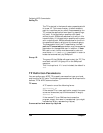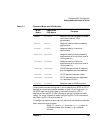
Chapter 7 191
Configuring APPC Communication
Defining TPs
about the TP is broadcast to all servers on the LAN; if
an LU on another computer receives an incoming
Allocate request and has no routing information
configured, it can dynamically locate the TP and route
the Allocate request to it.
Using this option avoids having to configure explicit
routing information on LUs, and enables
load-balancing by running more than one copy of the
same TP on different computers. However, if you want
to avoid broadcasting information in order to reduce
LAN traffic, or if you need to ensure that incoming
Allocate requests arriving at a particular LU are
always routed to the same copy of the TP, do not select
this option.
Full path to TP executable
The path and file name of the executable file for this
TP. If you do not provide the file name, SNAplus2
assumes that the executable file name is the same as
the TP name parameter.
If no path is specified, the default path for HP-UX
systems is /etc/TPname, where TPname is the TP
name parameter. For a Windows system, the system
uses the usual Windows mechanism to locate the
executable file.
The file must have execute permission for the user
specified by the User ID parameter. In addition, if the
executable file is to be run with User ID set to root, the
file must be owned by root and must have setuid and
setgid permission in order to be started automatically
by SNAplus2.
Arguments
Any command-line arguments to be passed to the TP,
separated by spaces. The arguments are passed to the
TP in the same order as they appear here.
This value is optional. If it is not included, the TP is
invoked without any command-line arguments.
User ID
The user ID that SNAplus2 uses to start the TP. This
line is required, and must be specified. The ID must be
a valid HP-UX login ID on the SNAplus2 computer.


















